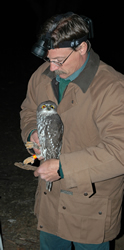Close eye on barking owls
Note: This content is stored on an archive website and may not be current or accurate. Contact us to clarify.
There is growing interest in new research techniques Forestry Corporation is using in the study of birds of prey.
The latest focus is on the threatened barking owl.
The Pilliga State Forests supports the largest known population of the birds in the State, but this owl is much more common in northern Australia.
“Our trapping and radio-tracking studies have brought interest from students in Brazil and France , with inquiries from around Australia ,” says Forestry Corporation principal research scientist Dr Rod Kavanagh.

Forestry Corporation principal research scientist Dr Rod Kavanagh with a captured barking owl.
Dr Kavanagh has been collaborating with the Department of Environment and Conservation on a study of the Pilliga barking owls for some years.
The current study has involved the trapping and radio tracking of nine birds across the Pilliga.
The trapping was conducted in June, with tracking sorties planned for the next six to nine months.
“We have had Marco Granzinolli from the University of Sao Paulo in Brazil and private bird tour operator Jonny Schoenjahn from Broome , Western Australia , working with us on the trapping,” Dr Kavanagh said.
“They were interested to study our techniques in trapping, harness attachment and radio-tracking.
“There is a volunteer coming out from France to study our operation, among others in Australia, and the president of the Australian Raptor Association, Victor Hurley, from Victoria is also interested in the project.”
A seldom-seen night stalker of the western bushland, the barking owl was listed in 1998 as a vulnerable species.
“This is part of the recovery plan for these birds,” said Dr Kavanagh.
“We hope to find just what habitat these birds use so we have a better idea of what it is that we should be managing to protect this species.”
Barking owls, Ninox connivens, are so named because of the ‘wook wook’ noise they make when calling to each other. Some liken it to the bark of a small dog.
So far Dr Kavanagh and other researchers have established that the Pilliga State Forests population may be the largest in southern Australia .
“We would expect the barking owl to also occur on private property in riparian forests and woodlands on the western slopes of NSW, and also on the North Coast, but these areas have not been adequately surveyed” Dr Kavanagh said.
The birds in the latest research were lured down at night with owl calls broadcast from a set of speakers using a laptop computer. They were then caught in nets strung between trees.
Once caught the birds were weighed and their other vital statistics recorded then outfitted with a hand-sown harness to hold the radio transmitter.
After release the birds were tracked during the day to determine where they were nesting and roosting, and at night to see where they were foraging and how far they travelled.
From this information researchers will be able to determine the vegetation, cover and other habitat requirements of the birds.
They can also determine much of the local diet of the birds from the regurgitated pellets collected beneath owl roosts.
The previous knowledge of barking owls suggested that they occupied riparian zones, so they were expected in these areas of the Pilliga, and also along the fringes of the forest where they could forage into more open areas.
But a recent survey found that the birds occupied a number of interior forest sections right across the western, central and northern Pilliga.
“This was counter-intuitive to our expectations based on the known habitat of the owls in other parts of southern Australia ” Dr Kavanagh said.
“We thought it might be because the birds were being recorded multiple times as they were attracted to new sites by the survey method, which involves call-playback from a loudspeaker. Records in Victoria have shown that this owl generally nested within 200 metres of the forest boundary.”
A meeting between the former State Forests and former National Parks and Wildlife Service officers last year decided to trap, fit radio collars and track the birds to determine their habitat use.
“We want to find what vegetation they use to roost in, the vegetation they nest in and the vegetation they forage in,” Dr Kavanagh said.
“We now have eight pairs with radio transmitters, and one pair where both birds have transmitters.
“The current study has targeted three pairs that are nesting in the creek systems, two pairs that occupy the hard edges of the forest boundaries, and three pairs that live deep within the forest interior and away from creek lines.”
The tracking work, which will occur over the next six to nine months, will determine where the birds roam and may have an impact on whether the present interim exclusion zones developed for this owl continue or are altered.
Media contact: Dr Rod Kavanagh on (02) 9872 0111.
For further photographs:
Howard Spencer
Public Affairs and Media
Department of Primary Industries
Ph: 02 66568800
howards@sf.nsw.gov.au

